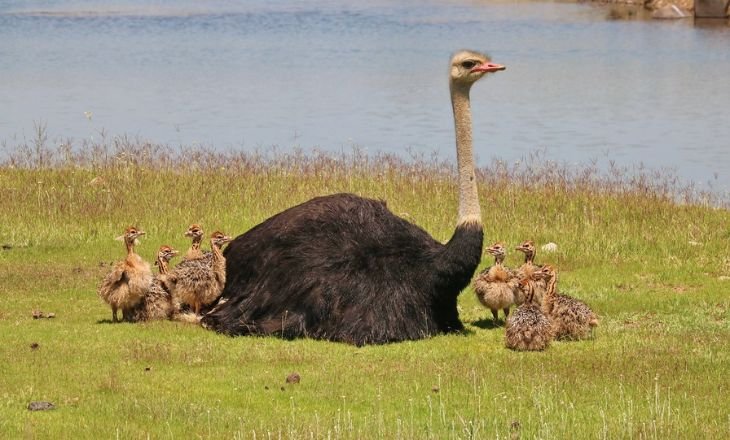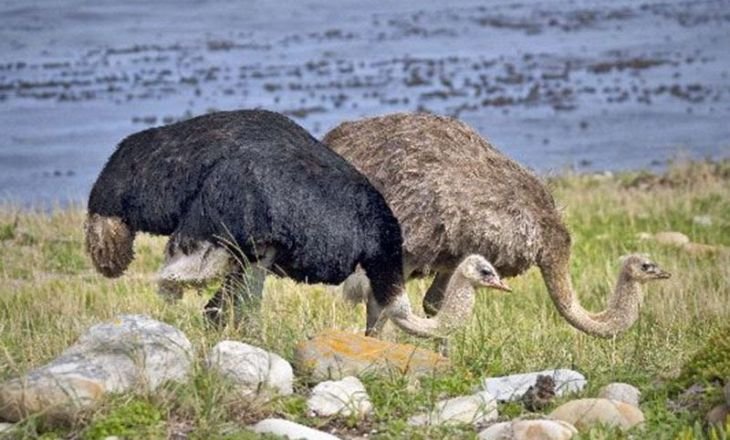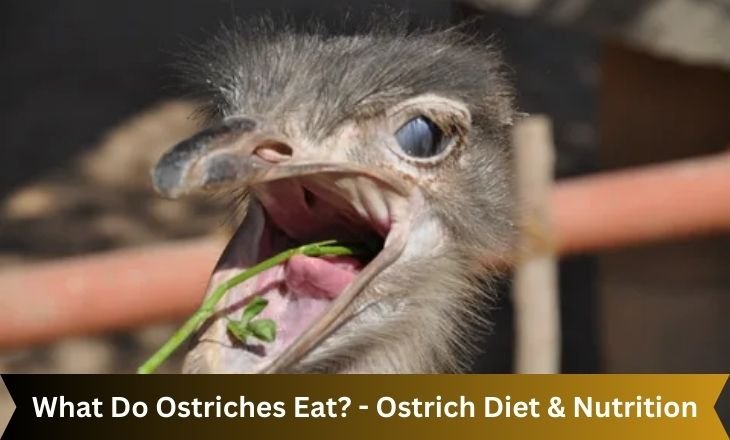These large, flightless birds are fast and have a unique look. A common question is: What do ostriches eat? Ostriches are not picky eaters; their diet shows how they adapt to their environment.
They eat a mix of plants and small insects, which keeps them strong and active. Learning about their diet helps us understand their role in their habitat and how they survive in tough conditions.
Join us as we explore the varied diet of ostriches and discover what keeps these amazing birds going every day.
What Do Ostriches Eat In Captivity
Ostriches in captivity eat different foods to stay healthy. They like high-fibre grasses, grains, and special pellets that give them protein and vitamins. They also enjoy fruits and vegetables as treats, which make their diet more interesting and resemble their natural foraging habits. Caretakers must watch portion sizes because too many sugary fruits can disrupt their nutrient balance.

Ostrich Diet
Ostriches are interesting omnivores with a unique diet. They mainly eat grasses, leaves, seeds, and fruits in the wild. Their digestive system is specially designed to handle tough plant materials. They have a large stomach that ferments food using stones they swallow from their surroundings, which helps them digest effectively.
Lifespan Ostrich
Ostriches can live up to 40 years in safe places, showing interesting facts about their biology and social behavior. Unlike many birds that fly, ostriches have adapted to life on land. They are the heaviest birds but can run fast.
They can sprint nearly 45 miles per hour, which helps them escape predators as they age. Threats from animals like lions and hyenas and harsh conditions often shorten their lifespan to about 15 years.
Ostrich Size And Weight
The ostrich is the largest bird in the world. It is unique because of its size and features. Weighing 220 to 350 pounds and standing up to 9 feet tall, these flightless birds move powerfully and gracefully across Africa’s savannahs.
Their size helps them scare off predators and find food in dry areas. Many people may not realize that their size affects their behavior. With long legs, ostriches can run faster than 45 miles per hour, making them quick protectors of the plains instead of flying birds.
Ostrich Egg Size
Ostrich eggs are the largest bird, weighing up to 3 pounds and measuring about 6 inches wide. Their size is important for the chick’s development. Unlike smaller eggs, the large egg gives the chick plenty of food and space to grow. One ostrich egg equals two dozen chicken eggs, making it impressive and useful for cooking.
Ostrich Behavior Characteristics
Ostriches are good at surviving and have social behaviours. These big birds can run quickly and use sounds and body movements to show their feelings. A dominant male puffs out his chest or walks confidently to show he is ready to protect the group and maintain his status.
Ostriches also have special ways of raising their young. During breeding, they create communal nests where several females lay their eggs. This teamwork helps the birds work together. Both male and female ostriches take turns sitting on the eggs, which increases the chances of more chicks surviving.
What Is An Ostrich Favorite Food
Ostriches are interesting animals known for their size and speed. They eat a mix of plants and proteins. Their favourite foods include grass, leaves, and seeds. They also enjoy fruits like melons and berries when they find them. This ability to eat different foods helps them live in various places, from savannas to deserts.
What stands out is how they find food. Unlike other birds peaking at food, ostriches use their strong beaks to search the ground. They also eat small insects or rodents when possible, making their foraging seem like a little adventure. This varied diet is important for survival, giving them the energy to run fast—up to 45 miles per hour!
Learning about what ostriches eat shows how clever they are and highlights the balance in their ecosystems that supports such amazing wildlife.
5 Interesting Facts About Ostrich
- Their legs can kick with over 2,000 pounds of force per square inch. This helps them defend against predators like lions and hyenas.
- Both male and female ostriches take turns incubating their eggs, which is rare among animals.
- A clutch can hold up to 15 eggs, with each egg weighing around three pounds.
- Ostriches have a special social structure. They live in groups called flocks, which usually contain 5 to 50 birds. A dominant male with bright feathers leads these flocks.
- Ostriches are known for their large size and speed but have some surprising secrets beyond their physical traits. These flightless birds can run as fast as 45 miles per hour.
Why Do Ostriches Eat Rocks
Ostriches have a strange habit that surprises many people: they eat rocks. This behaviour is important because ostriches have a special digestive system that needs these stones to help break down tough plants.
Unlike animals with complex stomachs, ostriches use gizzards where the stones, called gastroliths, help grind up the fibres in their plant-based diet. This process is not just for digestion; it helps them get important nutrients. Ostriches also choose specific sizes and shapes of rocks that work best for grinding.

Where Is Ostrich Found
The ostrich is the largest bird in the world. It mostly lives in Africa’s savannas and grasslands, including South Africa, Botswana, and Namibia, but it can also live in hot deserts and woodlands.
Ostriches prefer open spaces where they can see predators. Their sharp eyesight helps them spot movement from far away. Ostriches are important to the cultures in their native areas. In some regions, they support local economies through tourism and farming for their feathers, meat, and eggs.
Conclusion
The question is, what do ostriches eat? Their diet includes grasses, seeds, fruits, and leaves. They can also eat insects and small animals when needed, showing they can adapt to their surroundings.
Ostriches have a special digestive system that helps break down tough plants, making them fit for their natural homes. Knowing what ostriches eat is important for conservation and for people who care for them in captivity.
Understanding their dietary needs can help these amazing birds thrive in the wild and in human care. Let’s work together to protect their habitats!
Frequently Asked Question
How To Make Ostrich Feed?
Corn: 56
Wheat: 6
Soybean meal: 12
Bran: 3
Imported fish meal: 6
Alfalfa meal: 10
Salt: 0.4
Shell meal: 0.8
Bone meal: 3
Various nutrients: 2
What Fruit Do Ostriches Eat?
Ostriches eat various foods, including fruit, seeds, shrubs, and plants. Their diet includes frogs, roots, tortoises, small lizards, and insects. They sometimes eat dead animals and enjoy wild fruits like figs and berries.
How Many Eggs Do Ostriches Lay?
Under natural conditions, a female ostrich lays 12–18 eggs. Under farm conditions, young females produce 10–20 eggs in the first year and from 40 to 130 eggs annually (most often 40–60) in subsequent years.
What Is A Newborn Ostrich Called?
Like many other bird species, an ostrich baby is called a chick or a hatchling.

